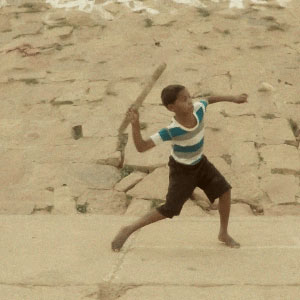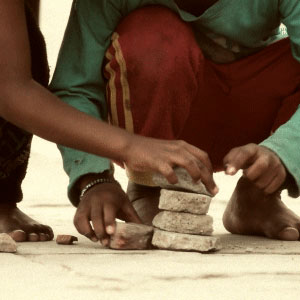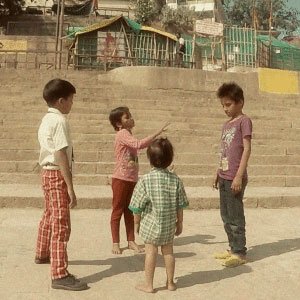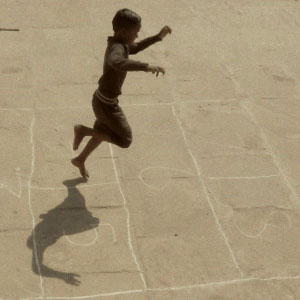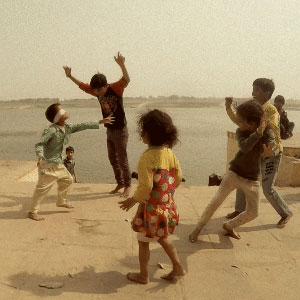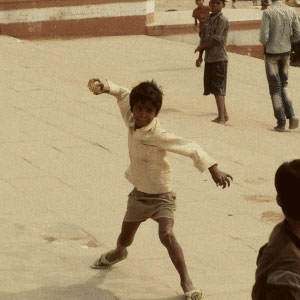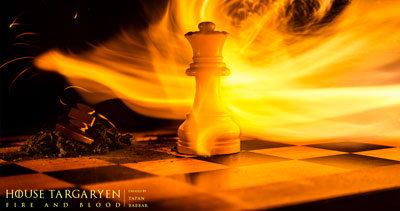
Gilli-Danda
While discussing games of Indian origin, Gilli Danda fares undisputedly as a first occurrence to many minds. It is believed to have originated 2500 years ago sometime during the Mauryan Empire.
Lead your parents or grandparents down the memory lane, and soon stories around this game start cropping up with narratives of priceless childhood friendships, injuries and damage to neighbours’ windows as common occurrences.
Premchand talks about the universal accessibility of gilli danda, of how it is indiscriminate in its offerings and how it can be played by both rich and poor. You don’t need a lawn, court, net or any other expensive equipment, a right sized twig from a tree and the game is on.

"Gilli Danda" is played with two pieces of wood - a danda which is a long wooden stick, and a three inch spindle-shaped gilli.
Standing in a small circle, of about four metres in diameter, the gilli is placed at the center on a stone, which is inclined to raise the gilli. The striker hits the gilli at the raised end with the danda, flipping it into the air.
If a fielder catches the gilli, the striker is out. If not, the fielder closest to the landed gilli tries to hit the danda. If the fielder is successful in hitting the danda, the striker is out; if not, he/she scores points based on the distance between the gilli and the center of the circle. The striker then gets another opportunity to strike. A striker is out if he/she misses to hit the gilli in three successive attempts. The team (or individual) with the most points wins the game.
-
Itti dakarSindhi
-
Guli badiOdiya
-
Kitti-pulTamil
-
Viti danduMarathi
-
Koyando-balKonkani
-
Chinni - chanduKannada
-
Gooti-BillaTelugu
-
DangguliBengali
Kanche (Marbles)
I was introduced to the concept of currency in the form of a miniscule shining glass sphere with mystical patterns - kancha. In a matter of months it was clear to me that the more marbles you have, the more respect you command on the street.
Besides the childhood game, a comprehensive barter system revolved around these marbles. While going back home in the school bus on a blazing afternoon, chilled water could be exchanged for a couple of marbles. I remember getting caught while trading marbles in my classroom, and eventually losing them - an act of betrayal which was most certainly committed by the girls sitting behind. (Sigh!)

The marbles are kept inside a circle, about 2 feet wide. One marble is called the shooter, and is used to strike the other marbles inside the circle, from outside the circle. The forefinger of the left hand is stretched back using the forefinger of the right hand, holding the marble in between. Now keeping the left thumb firm on the ground, aiming for the marbles inside the circle, the shooter marble is released. The marbles that are thrown outside the circle belong to the shooter.
In another version, a hole is dug in the ground, and the striker tries to throw all the marbles inside the hole. The ones that fail to enter the hole are in jeopardy. The other players ask the striker to hit the marbles that didn’t enter the hole. If he/she succeeds, then all the marbles belong to him/her, and if not the other players get a chance to try the same.
In both the versions of this Indian game, the player with the maximum marbles wins.
Gully Cricket
No soul in India, boys and girls alike, would have passed their childhood without playing cricket on the streets (not sure of the kids these days living in the multi storey apartment buildings). Every evening, the more enthusiastic kids left their homes to call their friends, gather equipment, and of course claim the pitch before someone else did. Makeshift wickets were created with bricks or were drawn on a wall.
The poor uncles/aunties with their houses next to the street had - let's confiscate the balls of poor kids - etched in their daily routine. Seriously, how much damage can a ball do to to your car’s windscreen ( Yeah! All right).
The strength on the park or the street would be proportional to India’s performance a day before. I remember the dry spell that came after the match fixing case in 2000 . I wonder what do the kids do during summer vacations these days, maybe getting the same (or not) thrill but on a virtual platform.

In addition to the rules of cricket, gully cricket has evolved with its own regulations. One tip- one hand out, winners to continue, dismissal if the ball goes in any house, three consecutive body touch - were few of the adaptations that were made as per the street conditions. In some moronic circumstances, the side that owned the bat used to bat first.
Chain-Chain (Chain Tag)
When pakdam pakdai (Tag) got boring, chain-chain (chain-tag) evolved to break from the mundaneness. The fun quotient escalated as more and more children joined the chain. The better runners were kept on the left and right wings as they were eventually going to “tag” or touch the other children. Being in the center of the chain was the least desirable spot, as you had nothing to contribute and at the same time got pulled from both ends. At times the chain manoeuvre used to outflank the remaining children and trap them in a circle.

One of the players is the seeker/denner/it, whose task is to catch the other players and grow the chain. Once a player gets caught he/she belongs to the seeking/denner team. Now both the players will try to catch the other kids and thus augmenting the chain.
In India, there are two variations of this childhood game - Band Chain (closed chain),when all the players in the seeking/denner team hold their hands while trying to catch the others, or Khuli chain ( open chain),when the seekers/denners can run freely without holding hands (imagine the debacle).
Pithoo
With cricket in the parking lot getting banned because of the melodramatic and highly irrational neighbours, pithoo became a long term substitute during the childhood days. In Kerala, this game is played with a ball made of coconut leaves.

A tower with seven stones is made and the players are divided into two teams. Each team gets three attempts to break the tower with a tennis ball. If the team fails to do so, the other team gets a chance. When any team succeeds in knocking over the tower, their aim is to rebuild the tower while the other team tries to hit the team building the tower, with the ball. If the first team builds the tower without getting hit, they win but if the defending team hits the striking team with the ball, the defending team wins. Both teams take alternate chances to strike the pithoo.
-
LagoriMaharashtra
-
SitoliyaRajasthan
-
SatodiyuGujarat
-
Bam PittoBihar
-
Yedu penkulataAndhra Pradesh
-
Dabba kaliKerala
-
Ezhu kalluTamil Nadu
-
GarmaanKashmir
Patang (Kite)
Kids too naive to understand the importance of freedom and not so much interested in the independence day speech, associated 15th August only with a sky filled with a gazillion kites. Makar Sankranti, Lohri are some other occasions in India which can bring back the nostalgia of flying kites to many, from their childhood days. During these festivals, the houses with a terrace get all haughty because of a better vantage point.
The air is filled with screams of victory when someone cuts another’s kite, yes correct - Kai Po che. That’s when the Kite runners get on their feet in order to be the first ones to grab the kite. In Varanasi this sport goes on till Holi, and then goes down gradually as the summer approaches.

There is just one rule to this game - Survive and thrive. Although there are some moral grounds that suggest that not more than two kites should duel. There are also a lot of safety rules to be kept in mind in order to avoid accidents. One should make sure that if flying on a terrace, there is proper fencing and while running on the streets to catch the kite, the eyes are on the road and not up in the sky. Kite lines can get tangled in the electrical power lines, resulting in power blackouts.
Chupan Chupai (Hide and Seek)
During my childhood, the only reason why I used to look forward to power outage at night was a game of Hide and Seek with friends. Before the backups came along, families used to go down for a stroll when the electricity used to bail on us, and kids - well, no one can force you to study in such a scenario. Pitch dark streets made for the ideal conditions for a game of Hide and Seek. At times certain evil kids of the group used to go back home before the game was over, and the poor denner kept on looking for them.

One of the player is chosen as denner/seeker/it and the other players hide themselves within the decided boundary. After counting till hundred with his/her eyes closed, the seeker announces the onset of his/her hunt. On finding a player, the denner/seeker/it calls out I-spy and the player who is caught is out of the game, while the denner/seeker/it proceeds to find the other players.
In India, the other players can defeat the denner/seeker/it by touching him before he/she does and call “dabba”. The same player repeats his/her den. If the denner/seeker/it finds all the players, the first player to get caught becomes denner/seeker/it.
Latto (Top)
I could never get the traditional rope top working. Thankfully in my childhood, the mechanical button operated tops with a starter came along, and I could get some of the action. The physics behind the lattu is based around what is called as the “Gyroscopic Effect”, which takes into consideration friction and inertia that balances the top. Around 6-7 years later cartoon network aired Beyblade in 2005 ( I had stopped watching cartoons) , and the then kids could be seen duelling their beyblades. This was a revival of tops, but in a new shiny package and for a completely different market segment. But soon cartoon Network went down, and so did the tops.

Top fights are a form of duelling where two players combat with their tops. The aim is knock off the other person’s top. The first one to do so while keeping their own top spinning wins. In India, another version of the game is to be the make your top spin the longest. All the players unwind their tops with their respective ropes simultaneously.
-
BambaramTamil Nadu
-
Bugurikarnataka
-
Bongaralu AataTelangana
Stapoo (Hopscotch)
Stapoo is a popular childhood game in the Indian subcontinent and every state plays this game with their own variations. As it doesn’t require any equipment besides a stone, the setup is very quick. My sister with her excellent aim, made up for the losses in cricket on the stapoo court. We used to beg/borrow/steal coal pieces from the press wala (used to heat the iron ) to draw the court. When each player completes one course of the court, we used to create custom courts by adding some difficulty.

The Playing Court is drawn on a flat surface (usually the floor of alleys) with the help of a piece of coal or chalk.
The first player tosses the stone into square number one. It can't touch any of the lines or bounce out. That player then jumps the course skipping the square having the stone (square number one in this case) , with one foot where there are single squares. Where there are two adjacent squares (3-4 or 6-7) they are straddled. The left foot lands in the left square and the right lands on the right. On reaching square number two, the player picks the stone and jumps to the initial position skipping square number one.
Upon successfully completing the course, the player continues the turn by tossing the stone into the next square (square number two), and similarly repeating the pattern.
If, while hopping through the court in either direction, the player steps on a line or puts both the feet on single squares, the turn ends. The first player to complete one course for every numbered square on the court wins the game.
In another variation the stone is kicked sequentially back through the course on the return trip and then kicked out.
-
Kith-KithNorth India
-
Ek-hat - Du-hatWest Bengal
-
ChirpiMaharashtra
-
Kunte billeKarnataka
-
PaandiTamil Nadu
-
Tokkudu BillaAndhra Pradesh
-
Chindroo
-
Picho
Aankh Micholi (Blindfold)
Blindfold is another crazy variation of ‘Tag’ where the denner/”It” is blindfolded with a handkerchief. To cheat was convenient and children would mostly loosen up the handkerchief allowing visibility. The next challenge was to fake that you cannot see, by doing a couple of bluff moves. But most of the times, the game took a violent turn, with the blindfolded denner getting beaten up by the other children. Obviously the favours were returned when the den changed.

After blindfolding, the denner is rotated three times to disorient them. The aim is to touch/tag another player, who then becomes the denner/”it”. A boundary is set, outside which the players are not allowed to move. The denner is warned with claps if he/she goes outside the decided boundary. To spice up this childhood game, players tease the denner to signal him/her towards them. In India, blindfold is popularly known as “Aankh Micholi”
Maram Pitti (Dodgeball)
All the scores were settled during the school lunch break while playing dodgeball. Kids used to gang up on pre-decided soft targets. Monsoons were a nightmare because the ground had puddles and getting hit by a ball soaked in water had a lasting impression, quite literally. Worst was to fall on the ground next to the player having the ball and become a victim of repeated strikes.

The ball is thrown in the air, and the players run to catch the ball first. Each player tries to hit the other players with the ball. The player who gets hit is eliminated from the game. Usually a boundary is decided beyond which the players cannot go. The last player to survive elimination wins. This childhood game, when played just for fun, is without the elimination and goes on for a decided period of time. In India, Dodgeball is popularly known as “Maram Pitti”.

